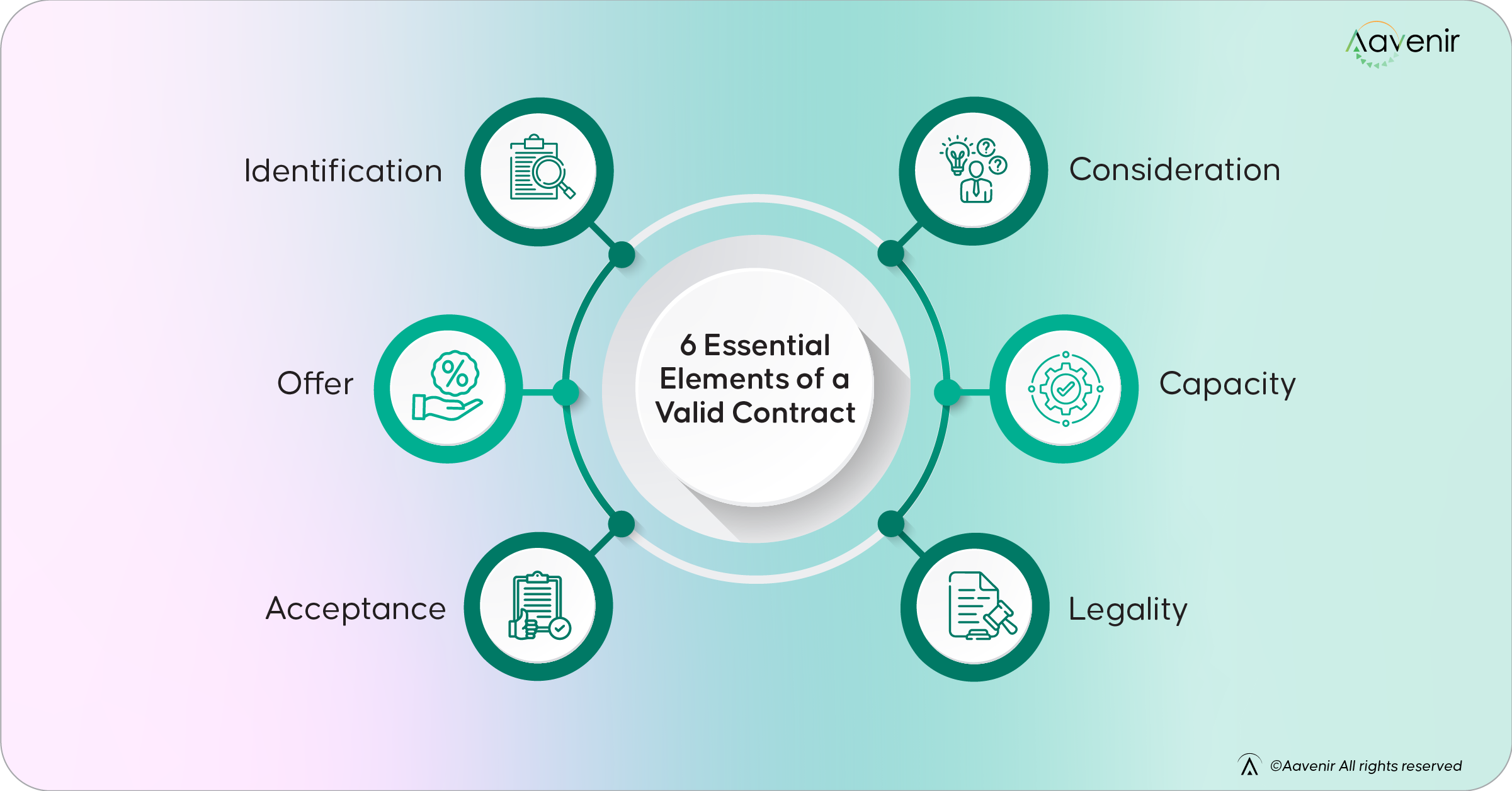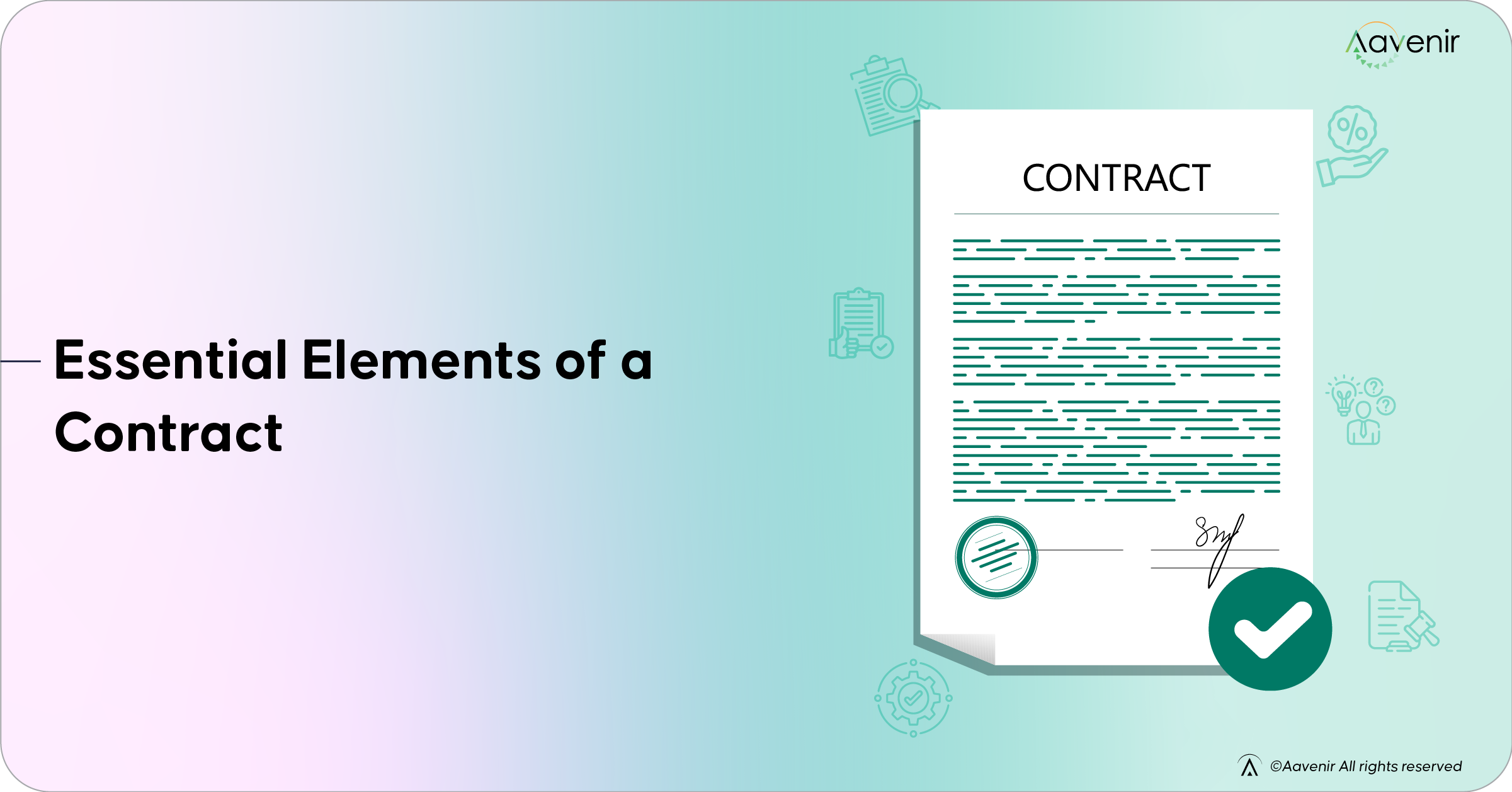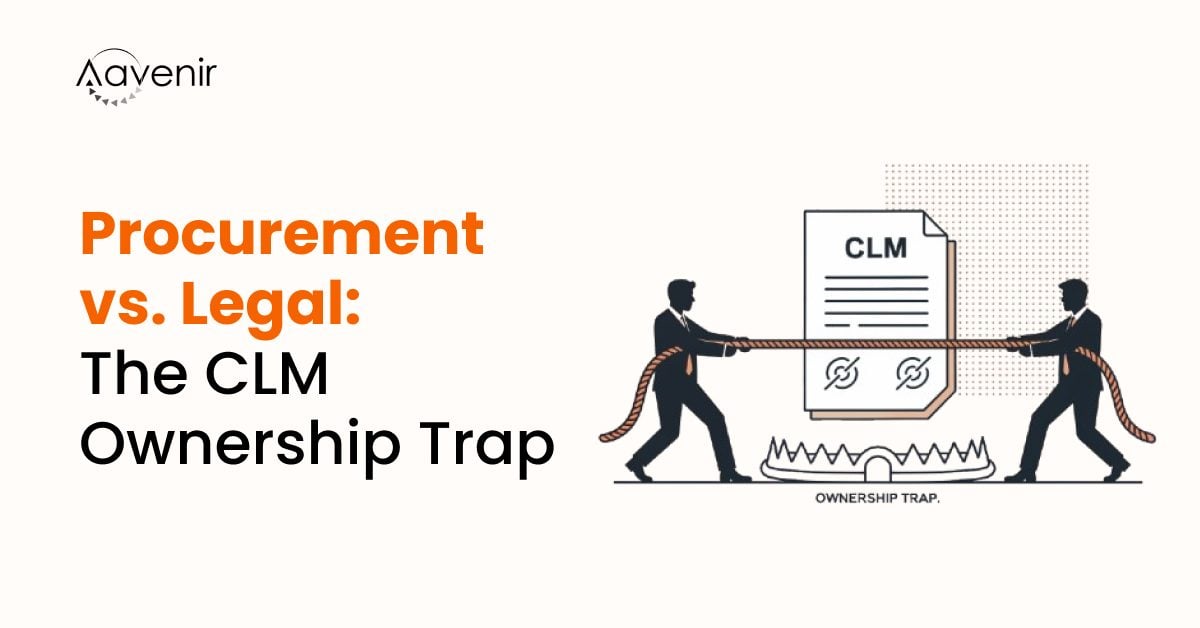Understanding key elements of contract management enhances efficiency, reduces disputes, and drives strategic value. This empowers enterprise contract teams to mitigate risks, foster long-term partnerships, and ensure legal compliance.
Moreover, it allows teams to streamline their Contract Lifecycle Management (CLM) process—from contract creation and negotiation to execution and renewal.
In this article, we will examine six essential elements of a contract and how enterprises can ensure their proper implementation.
6 Essential Elements of a Valid Contract
These elements are deemed essential because they provide key details about a contract, such as the parties involved, the value exchange, and the compliance requirements.
1. Identification
Identification establishes the parties bound by the contract. This element is essential because it establishes who the agreement binds and outlines the responsibilities and rights, ensuring accountability throughout the contract’s lifecycle.
A valid contract unambiguously identifies the parties using their full legal names, official business titles, or other unique identifiers relevant to the nature of the agreement.
Acceptable identification for individuals might include government IDs or other formal documentation. Similarly, for businesses, it contains registered names, entity types, and additional details such as parent organizations or subsidiaries, if applicable.
Incomplete, incorrect, or informal identification of parties in a contract increases the risk of disputes and could even render the contract unenforceable. This may occur due to uncertainty about the parties’ roles, rights, or obligations.
Therefore, enterprises must cross-check and verify relevant details, such as business registrations, addresses, and other identifying information, before signing the contract.
2. Offer
One party makes an offer to another, expressing the willingness to enter into a legally binding contract. The offer defines the terms and conditions, forming the contract’s foundation.
A valid contract offer must be precise, intentional, and communicated effectively to the intended recipient. To achieve this, teams need to clearly define the essential aspects of an offer, such as price, scope of work, and deadlines in the contract.
Most importantly, if the intended party accepts the proposal, the offering party should recognize it as legally binding.
For example, a detailed raw material request sent through officials with authority to a vendor qualifies as an offer. At the same time, a casual discussion or preliminary negotiation over a phone call does not qualify as a valid contract offer.
Similarly, advertisements, invitations to negotiate, and other forms of communication lack the specificity and unambiguous intent required to bind parties legally. For instance, a Request For Proposals (RFP) is an invitation to negotiate, not an offer.
It is crucial for contract management teams to differentiate between actual offers and casual discussions to avoid misunderstandings.
3. Acceptance
Acceptance occurs when the offeree (the party receiving the offer) accepts the terms and intends to enter a legally binding agreement. It marks the creation of the contract, provided the acceptance matches the offer and is communicated appropriately.
A valid acceptance is an unequivocal agreement to the offer’s terms without modifications. This approval can be given orally, in writing, or through conduct that indicates acceptance, such as beginning performance under the contract.
However, if the offeree requests or suggests changes to the contract terms, this constitutes a counteroffer, not an acceptance, and requires further negotiation.
Contract management teams in enterprises must document the acceptance to avoid miscommunication, disputes, and compliance risks. Verbal acceptance, for instance, can pose these challenges due to the lack of proof, making enforcement and accountability difficult.
Large organizations can better handle acceptance by implementing standardized processes through CLM platforms.
These solutions allow teams to capture acceptance in writing, such as eSignatures, enabling secure and timestamped tracking of contract approvals.

4. Consideration
Consideration refers to the goods, services, or anything of value exchanged between parties in a contract. It highlights what each stakeholder gains from the agreement, forming the basis for the mutual obligations and making the contract legally enforceable.
A valid consideration can take many forms as long as it is legally recognized by the parties as valuable. It can include money, products, or a promise to refrain from an action. For example, a buyer provides payment in exchange for raw materials
Enterprise contract management teams may encounter non-monetary considerations like trade-offs, IOUs, and exclusive rights. These considerations are valid if they are tangible, lawful, and mutually acknowledged.
For instance, an assurance to perform an illegal act is an invalid consideration.
Furthermore, the agreed-upon considerations may not be equal if they are deemed sufficient by the parties at the time of contract creation. Courts do not evaluate the fairness of exchange so long as the consideration is legally valid.
This makes it pivotal for contract teams to examine the consideration terms intricately to ensure they align with their organization’s best interests. Enterprises should also evaluate the consideration’s fairness, sufficiency, and compliance before agreeing to the terms.
5. Capacity
Capacity ensures that all parties to the contract understand the terms, have the authority to agree, and are legally permitted to participate in the agreement. Lack of capacity results in an unenforceable contract because the parties’ authorization is deemed void.
The validity of the capacity of the parties of a contract is determined by several factors.
The individuals driving the discussion must be of legal age, mentally competent, and not under the influence of substances or duress. Similarly, for businesses, the signing party should have the authority to bind their organization legally.
Additional factors, such as insolvency, bankruptcy, or restrictions in the corporate charter, can also affect a party’s capacity to validate a contract.
Moreover, there may be exceptions. For instance, a minor with legal guardians may be able to authorize contracts.
Contract teams in enterprises and large corporations must conduct due diligence to validate the capacity of the individuals authorizing a particular contract. This includes verifying age, business capacity, and mental competence.
Other areas of focus while validating capacity include board resolutions and corporate bylaws.
CLM software can expedite the overall process. Teams can build automated workflows that validate signatory roles based on predefined criteria to ensure compliance with legal requirements.
6. Legality
Legality ensures that a contract complies with the applicable laws and regulations. This essential contract element ensures an agreement has a lawful objective by invalidating or voiding contracts involving illegal activities or violating public policies.
A contract can be deemed legally valid if it adheres to local, national, or internal laws surrounding the subject matter. For instance, employment agreements should comply with the labor laws of the relevant jurisdictions.
Moreover, industry-specific guidelines, such as privacy and data protection laws for technology agreements, further shape legality. Therefore, all parties involved need to stay updated on the latest regulatory developments related to the contract at hand.
Apart from violating relevant public policies or industry-specific regulations, contracts can be deemed illegal if they contain fraudulent terms, misrepresentation, or unconscionable clauses that disproportionately favor one party.
It is crucial for enterprise contract teams to employ rigorous contract review processes to ensure legality.
Requirements for a Valid Contract: Beyond the Essential Elements
The above six key elements to include in a contract constitute the essential elements of a contract, forming the foundation of its validity. However, those are not all of the elements. There are several more components of a contract, depending on the scenario, that contribute toward the overall practicality, enforceability, and compliance of the contract.
Let’s look at these additional requirements.
Proper Subject Matter
A contract is said to have proper subject matter when its contents are legally permissible. The terms, obligations, and other aspects of a contract should not involve illegal activities or promote unethical practices.
The fundamental elements mentioned above, such as capacity, offer, and consideration, should comply with public policy. The contracts that contravene any regulatory standard of applicable jurisdiction are deemed unenforceable.
Payment Terms
The payment terms should include all the details, such as amounts, timelines, and methods. Highlighting the agreed-upon considerations prevents disputes over monetary obligations.
Dispute Resolution
Disputes are inevitable in businesses. There can be oversights or external factors that disrupt regular operations and workflow. It is, hence, critical to have strategies and protocols in place to deal with disagreements and conflicts.
Standard methods of dispute resolution for enterprises include:
- Arbitration: Receiving a solution from an independent third party, called the arbitrator. The arbitrator is chosen mutually by the parties. This process is private and much faster than typical court proceedings. The arbitrator’s decision is usually enforceable and legally binding.
- Mediation: The mediator, a mutually chosen independent third party, facilitates communication between the parties in disagreement to reach a mutually beneficial solution.
- Litigation: This is where the resolution is reached via the court system. It involves filing lawsuits, presenting evidence, and following general legal procedures. Due to the nature of this process, it is often the longest and could be costly.
Confidentiality and NDA
Confidentiality clauses or non-disclosure agreements (NDAs) specify each party’s obligations to protect sensitive information, such as trade secrets or intellectual property.
A breach of confidentiality within a contract lifecycle can result in severe legal and financial repercussions. Moreover, the party guilty of the breach may face irreparable reputational damage. This importance makes these provisions non-negotiable for most enterprises.
Force Majeure
Unforeseen circumstances, such as natural disasters, pandemics, or geopolitical reasons, can prevent parties in a contract from fulfilling their obligations sufficiently.
The force majeure clauses outline conditions when contractual obligations may be suspended or even terminated. It is pivotal for enterprises to tailor force majeure clauses to their industry-specific risks for maximum protection.
Termination and Exit Strategy
Termination clauses clarify when a party can exit the contract with or without a cause. This ensures smooth disengagement and avoids disagreements or conflicts.
Depending on the contract type, the termination and exit strategy clauses may include details such as notice periods, penalties, or the return of materials.
Create and Manage Valid Contracts with CLM Software
Ensuring each component of a contract meets expectations can be challenging, especially in modern enterprises where teams manage multiple contracts simultaneously.
Aavenir Contract Lifecycle Management (CLM) solution simplifies this by standardizing the essential contract elements with the following capabilities:
- Contract Intake Forms: Streamline contract initiation using structured intake forms for identification and offer proof attachments, ensuring consistency and compliance
- Contract Request Workflows: Automate and standardize contract acceptance processes to enhance efficiency and maintain structured approvals
- Past Contract Performance Data & Risk Assessment: Integrate past contract performance insights with GRC tools to assess vendor risk, ensuring compliance, consideration, and legal validity
- Clause Libraries & Contract Templates: Utilize pre-approved templates and clause libraries to maintain contract integrity and meet essential legal and business requirements
There’s more…
Aavenir also offers features, such as a centralized contract repository, AI-enabled metadata extraction, and AI assistants, to help enterprises master each contract element.
Want to enhance your CLM workflows with Aavenir?
Contact us today to book a personalized demo.
Frequently Asked Questions
What are the key elements that make a contract legally binding?
The six key elements of a contract include identification, offer, acceptance, consideration, capacity, and legality. These foundational elements shape the contract and provide necessary details to all parties involved.
Can a verbal agreement be considered a valid acceptance?
Yes, verbal agreements can initiate a contract and hold the relevant party accountable. However, they can be harder to enforce due to the lack of tangible proof, especially in modern enterprise environments. Written acceptance, through eSignatures, for instance, is significantly better.
What happens if one of the essential elements of a contract is missing?
Contracts missing key elements can be considered void or unenforceable. Additionally, they can lead to disputes, financial loss, and reputational damage.
How can businesses ensure their contracts are enforceable across jurisdictions?
Contract management teams must consult legal experts to include relevant legal clauses for each applicable jurisdiction. This will ensure the contract’s validity in the desired regions.
What are the common mistakes to avoid when drafting a business contract?
Authoring teams should avoid vague language, missing key clauses (e.g., dispute resolution), inconsistent review processes, and failing to ensure signatory authority while drafting a business contract.



